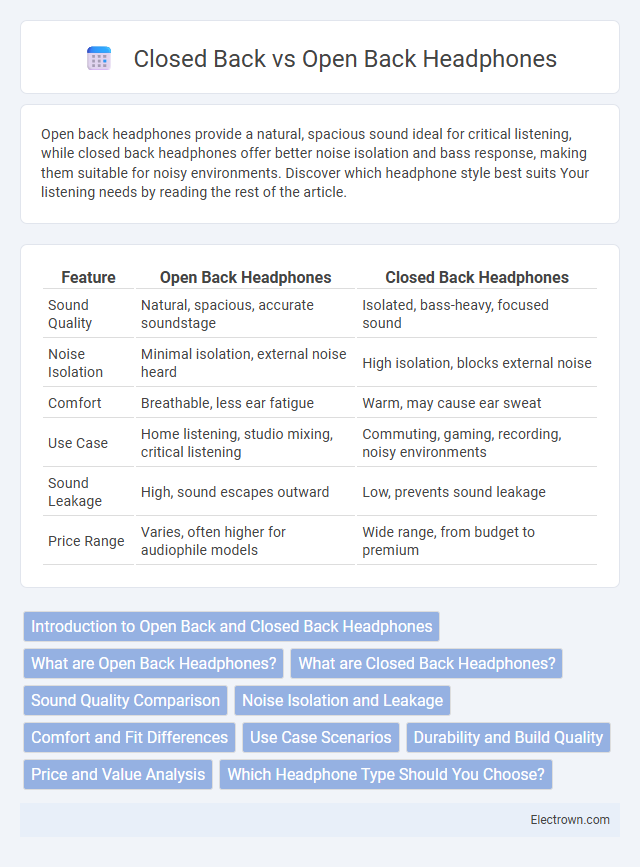Open back headphones provide a natural, spacious sound ideal for critical listening, while closed back headphones offer better noise isolation and bass response, making them suitable for noisy environments. Discover which headphone style best suits Your listening needs by reading the rest of the article.
Table of Comparison
| Feature | Open Back Headphones | Closed Back Headphones |
|---|---|---|
| Sound Quality | Natural, spacious, accurate soundstage | Isolated, bass-heavy, focused sound |
| Noise Isolation | Minimal isolation, external noise heard | High isolation, blocks external noise |
| Comfort | Breathable, less ear fatigue | Warm, may cause ear sweat |
| Use Case | Home listening, studio mixing, critical listening | Commuting, gaming, recording, noisy environments |
| Sound Leakage | High, sound escapes outward | Low, prevents sound leakage |
| Price Range | Varies, often higher for audiophile models | Wide range, from budget to premium |
Introduction to Open Back and Closed Back Headphones
Open back headphones feature ear cups with perforations or grills, allowing air and sound to pass freely, resulting in a more natural and spacious audio experience. Closed back headphones have solid ear cups that isolate sound by preventing audio leakage and external noise intrusion, enhancing privacy and bass response. These design differences impact sound quality, comfort, and use cases such as studio monitoring versus casual listening.
What are Open Back Headphones?
Open back headphones feature ear cups with perforated or mesh panels that allow air and sound to pass freely through the ear cups. This design provides a more natural, spacious soundstage and reduces ear fatigue by minimizing pressure buildup around your ears. You experience clearer audio with enhanced detail and less bass exaggeration, making them ideal for critical listening and mixing.
What are Closed Back Headphones?
Closed back headphones feature ear cups designed with solid outer shells that provide excellent noise isolation by blocking external sounds. These headphones are ideal for environments where minimizing sound leakage and maintaining privacy are crucial, such as in recording studios or public spaces. Your listening experience benefits from enhanced bass response and reduced ambient distractions, making closed back headphones perfect for focused audio sessions.
Sound Quality Comparison
Open back headphones offer a more natural, spacious soundstage with clearer high and mid frequencies due to their design, allowing sound to flow freely. Closed back headphones provide enhanced bass response and better isolation, resulting in a more focused audio experience with reduced external noise interference. Audiophiles often choose open back models for critical listening, while closed back headphones are preferred in noisy environments or for bass-heavy genres.
Noise Isolation and Leakage
Open back headphones provide minimal noise isolation due to their design that allows air and sound to pass freely, resulting in significant sound leakage both inward and outward. Closed back headphones feature sealed ear cups that effectively block external noise and prevent sound from escaping, offering superior noise isolation and reducing disturbance to others. Your choice depends on whether you prioritize immersive sound with natural acoustics (open back) or a controlled listening environment with privacy and minimal external interference (closed back).
Comfort and Fit Differences
Open back headphones typically offer greater comfort due to their lightweight design and breathability, allowing air to circulate around the ears and reducing heat buildup during extended use. Closed back headphones provide a snug fit with cushioned ear cups that offer better isolation but may cause more pressure and heat around the ears, potentially affecting comfort over long listening sessions. Users seeking comfort for prolonged wear often prefer open back models, while those needing secure fit and noise isolation may lean toward closed back options despite potential discomfort.
Use Case Scenarios
Open back headphones provide a spacious, natural sound ideal for home listening, studio mixing, or any scenario where sound leakage is not an issue. Closed back headphones excel in noise isolation, making them perfect for commuting, office environments, or public places where blocking external noise is critical. Choosing the right design depends on your use case, whether you prioritize immersive audio quality or practical noise control.
Durability and Build Quality
Open back headphones typically feature a more delicate design with exposed ear cups, making them less durable and more susceptible to damage from drops or environmental factors compared to closed back models. Closed back headphones often use sturdier materials and reinforced enclosures, enhancing their build quality for frequent travel and rough handling. Users seeking long-lasting headphones with robust construction often prefer closed back options due to their superior durability.
Price and Value Analysis
Open back headphones generally offer superior soundstage and detail at a mid-range price, providing excellent value for audiophiles seeking quality audio experience. Closed back models tend to be priced similarly or higher but prioritize noise isolation and portability, making them ideal for professional or travel use where external sound needs to be minimized. Evaluating price against personal usage preferences and sound quality requirements ensures optimal value in the open back versus closed back headphone decision.
Which Headphone Type Should You Choose?
Open back headphones offer a natural, spacious sound ideal for critical listening and home environments, while closed back headphones provide better noise isolation and bass response, making them suitable for noisy settings and portable use. Your choice depends on whether you prioritize soundstage and ventilation or isolation and portability. Consider your primary listening environment and audio needs to select the best headphone type for you.
Open Back vs Closed Back Headphones Infographic

 electrown.com
electrown.com